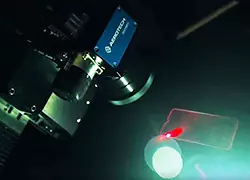What Is Motion Control Programming?
Motion control programming is the process of writing the software instructions that define and execute automated machinery’s precise physical...
Work with our team to determine which products or systems are the best fit for your application.
Some Aerotech products are available for immediate order in North America through our partner Motion Plus.

A case study examining display production that optimizes quality and throughput – and lower total cost.
Motion control software is the indispensable digital operating system that transforms abstract automation goals into real-world, precisely coordinated machine movement. It is the crucial layer that connects a programmer’s intent with the physical hardware, managing the entire process from trajectory planning to real-time closed-loop error correction. This software environment dictates the flexibility, integration potential and achievable accuracy of any automated system.
Proficiency in this environment, often addressed through high-level commands, is the focus of motion controller programming. By harmonizing the computational demands of real-time control with user-friendly development tools, motion control software enables the highest standards of performance required for precision motion control.
Motion control software typically consists of two primary architectural components: a user-facing Integrated Development Environment (IDE) and a real-time deterministic motion controller. The IDE is the software suite used by engineers for machine configuration, application development and diagnostics. It provides the tools for defining kinematics, setting motion parameters, writing code (e.g., scripts, G-code) and performing tuning. This non-real-time component is designed for usability and flexibility.
The second part is the embedded, real-time deterministic software that resides within the controller hardware. This component is responsible for the continuous, high-speed execution of the servo control loop at a fixed update rate (e.g., 20 kHz). This real-time controller generates commands for the precise control of motors and actuators to achieve desired motion profiles and corrects for any positional error reported by feedback devices. The seamless interaction between these two parts is what enables complex, synchronized movement. Motion control in robotics is a key application of this software, as it is used to perform the inverse kinematic calculations necessary to command multiple joints to move the tool center point along a smooth path.
Motion software is used across a vast spectrum of industries for automation, robotics and complex manufacturing processes, serving as the central hub for executing and monitoring machine functionality. Its primary purpose is to enable precise and highly repeatable physical tasks that human operators or simpler control systems cannot achieve.
Specifically, motion software is used to enable key tasks such as:
Positioning and Synchronization: Moving one or multiple axes to specific coordinates and synchronizing their movements for tasks like electronic gearing, camming and multi-axis interpolation
Speed and Force Control: Regulating motor velocity and acceleration profiles to minimize vibration, as well as applying specific force or torque levels in demanding applications
Trajectory Planning: Interpreting complex geometric data (like G-code from a CAD/CAM system) and translating it into smooth, time-based movement commands that respect the physical limits of the machine
Diagnostics and Tuning: Providing real-time data plotting and analytical tools to ensure the servo loop is stable and optimized for maximum bandwidth
The efficiency and precision gains realized through the software make industrial motion control software a common choice in manufacturing, particularly for high-value applications where quality and throughput are critical.
Yes, the vast majority of modern, high-performance motion controllers provide Application Programming Interfaces (APIs) for integration with other software systems. The API is a library of pre-defined functions and commands that allows external software—such as a custom HMI, a factory-wide Supervisory Control and Data Acquisition (SCADA) system, or an analytical PC application—to communicate directly with the motion controller.
APIs facilitate communication between the motion control software and external applications by standardizing how complex motion functions (like "MoveAbsolute" or "EnableAxis") are called and executed. This eliminates the need for developers to program low-level communication protocols.
Typical API wrappers are available for common high-level languages like Python, C#, .NET, and LabVIEW. The use of APIs is becoming increasingly important for advanced machine design, as motion control AI can leverage these interfaces to feed real-time optimization parameters back into the controller or to analyze high-speed data streams for enhanced functionality and predictive maintenance.
Creating a Graphical User Interface (GUI) for a precision motion controller is a crucial step in transforming a complex piece of engineering into a user-friendly machine. The process should start by defining the user requirements and functionalities needed, such as manual jogging, program selection, real-time status display (position/velocity), and alarm reporting.
There are two main approaches to developing the GUI:
Traditional Programming: Use common programming languages and frameworks that support GUI development, such as Python (using libraries like Tkinter or PyQt) or C# (using WPF or Windows Forms). This approach leverages the controller's API to send motion commands and retrieve status data. This offers maximum customization but requires a skilled software developer.
Low-Code/No-Code Solutions: Choose a motion controller that provides a low-code or no-code operator interface environment, such as the Automation1 MachineApps platform. These tools allow a controls engineer or technician to customize a complex GUI using pre-built widgets, drag-and-drop functionality and visual configuration. This approach drastically reduces reliance on software development resources and accelerates deployment.
Regardless of the method chosen, the GUI serves as the operator's gateway to the machine's capabilities. Precision motion control programming software often includes these drag-and-drop HMI builders to simplify and standardize the development of a professional, functional interface.
Have questions about precision motion control? Ask our experts!
Motion control programming is the process of writing the software instructions that define and execute automated machinery’s precise physical...
Precision Motion Controller A precision motion controller is the central computing engine designed specifically to meet the stringent demands of...
The core difference between a Programmable Logic Controller (PLC) and a motion controller lies in their primary function, computational focus and...